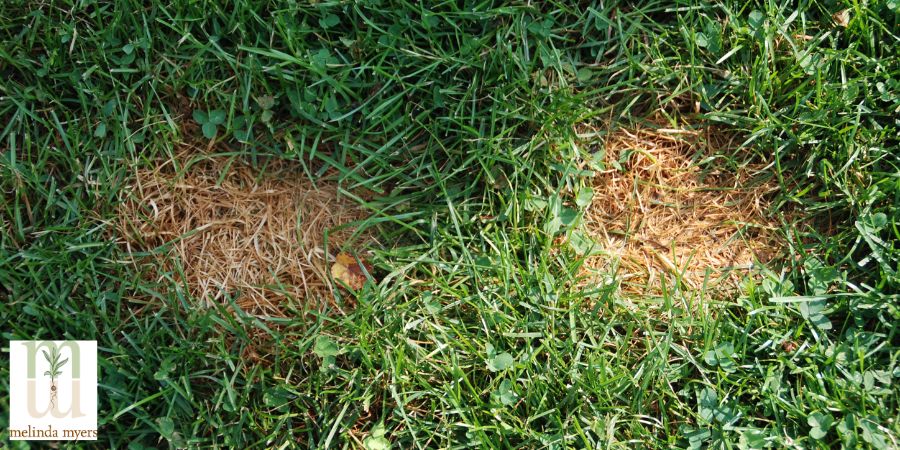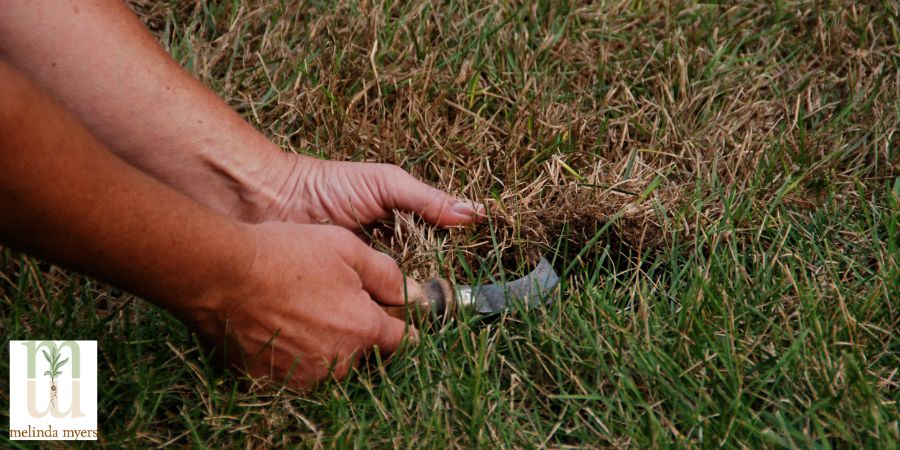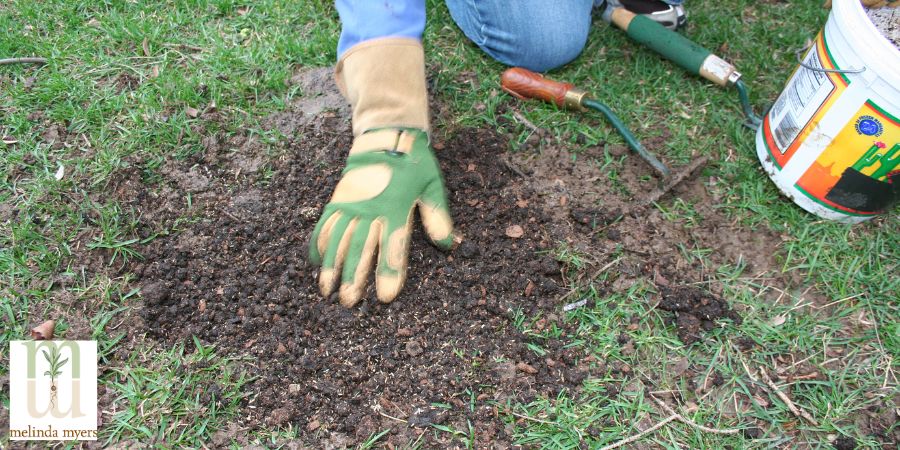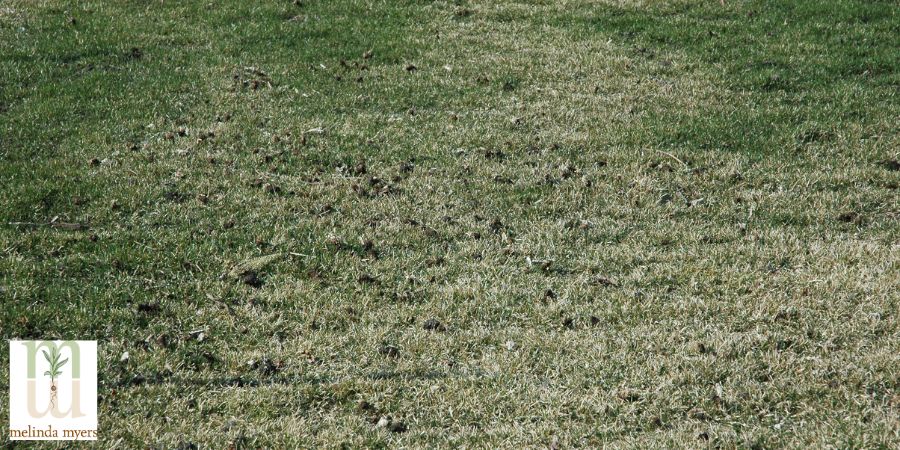Renew, Repair or Renovate Your Lawn
- horticulturist and gardening expertApril 27, 2024
Extreme heat and drought, flooding, fluctuating winter temperatures, dog spots, and deicing salt damage may have caused dead spots or thin areas of your lawn. If no more than 30 to 50% of your lawn is filled with weeds or damaged, renovation can help you boost its appearance without killing the grass and starting over. It will take time, water, and effort on your part, so like any other project, make a plan and schedule the work when it's best for the lawn and your schedule.

Dog Spots
Identify and Fix the Cause of the Lawn Problem
Before you do anything determine the cause of the lawn’s decline and make needed corrections. Skipping this step can have you repeating the renovation in just a few years. Here are some of the more common causes that may have caused your lawn to decline.
Compacted soil restricts plant growth and is a major cause of lawn thinning and decline. Heavy rains, foot traffic, pet runs and equipment can compress the soil so it retains water longer and that water drains much more slowly. Aeration that creates openings in the soil and topdressing with compost can help alleviate this problem.
Thatch buildup of more than ½” can prevent water and nutrients from reaching the grass roots and cause thinning of the lawn. If you have been too kind to your lawn by overwatering and overfertilizing it is at greater risk for thatch buildup. If you regularly leave long clippings on the lawn, these can contribute to the problem. Short clippings are not a contributor as they break down quickly, adding nutrients, organic matter, and moisture to the soil. Don’t worry if your lawn has a thin layer of thatch. It acts as a mulch and is not detrimental to your lawn’s health and beauty. Dethatching the lawn when it is actively growing not only removes the thatch but increases seed-to-soil contact when overseeding.

Checking for Thatch in the Yard
Shade from maturing trees and shrubs, structures, or your home create shade that is not good for the sun-loving lawn grasses. Perhaps you tried planting a more shade tolerant grass seed or had a certified arborist thin the canopy of the tree shading the area. If the lawn is still struggling, it is time to consider an alternative. Shade-tolerant groundcovers or mulch may be the only effective solution. I did have one homeowner tell me he grew grass in the shade. When I asked about his secret to success, he told me he planted new grass every spring. Not a practical solution for most of us.
How to Time Seeding Your Lawn
Since plant growth is dependent on the weather, it is important to time your renovation based on the grass you are growing. Cool-season grasses like bluegrass, fescue, and perennial rye are best renovated in the fall when the soil is warm, and the temperatures are usually a bit cooler, perfect for seed sprouting. Renewing the lawn in spring is the second-best time, but the stress of hot, dry summers can make it more difficult for the grass to establish, and you will spend more time watering.
Renovate warm-season grasses like centipede, Bermuda grass, carpetgrass, zoysia, St. Augustine and Bahia in spring or early summer. Those renovated in the fall may not have time to establish and are more subject to winter injury.
Fixing Bare Spots in the Lawn
Repairing small areas is a bit easier and can be done at the start of the grass-growing season. Start by using a garden rake to remove enough of the dead grass so you can see the soil below. This also roughens the soil surface to improve seed-to-soil contact for better germination.
Next, remove any weeds that have moved into this spot. Dig up the weeds, roots and all, or spot treat with a total vegetation killer. Check the label for application rates and the number of days you must wait before safely planting seeds.

Fixing a bare spot in the lawn
You may opt to purchase a lawn patch kit that includes grass seed and mulch. Or save money and make your own by mixing a handful of grass seed and Milorganite in a bucket of topsoil. This is a cheap way to fix patchy lawns. The nutrients in Milorganite help speed up lawn development and the slow-release nitrogen won’t harm seedlings as it releases small amounts of nutrients the developing grass needs over time.
Sprinkle the grass seed, Milorganite and soil mixture over the soil surface and gently water to help settle the soil mix. Mist it often enough to keep the seeds moist until they germinate in several weeks. Follow the label directions when using a commercial lawn patch kit.
Renovating the Lawn Without Killing the Grass
If your lawn is thin and sparse you create a dense turf that looks good and is better able to compete with weeds by overseeding with the recommended grass seed.
Have the soil tested before getting started. The test report will tell you how much if any fertilizer is needed. This can also give you a clue if fertilization or nutrient deficiencies are the cause of your lawns decline.
Most university extension services have a soil testing lab or can direct you to a state-certified lab. Home tests are not always accurate, and the minimal investment in a soil test can save you money and time and help you achieve better results from all your renovation efforts.
Next, consider managing existing weeds before overseeding or repairing dead patches. Doing this prior to repairing the lawn greatly increases your success. For small areas and small weed populations, you may opt to dig up the weeds, roots, and all, or spot treat with a total vegetation killer. These products will kill any good grass as well as the weeds it contacts. Always check the label for safe application and the required number of days to wait before planting seeds.
A broadleaf weedkiller is more targeted and only kills non-grassy weeds like dandelions but does not harm the grass. These require a longer wait time between application of the weedkiller and seeding the area. Again, check the label to avoid wasting your time and grass seed by overseeding too soon after applying the herbicide.
Eliminating this step can result in poor results and more time spent managing weeds in the future.
Mow grass shorter than normal and remove the clippings and any other debris by sweeping or raking. This helps expose the soil allowing the seeds to reach the soil for better seed-to-soil contact needed for sprouting.
Remove thatch, layer of dead grass at the soil surface, when its thicker than ½”. A vertical mower, power rake or other dethatching equipment is usually needed to manage this task. Most of these can be rented and you may want to team up with neighbors to share the cost.
Consider core aerating if the soil is compacted. Core aeration removes plugs of soil creating holes in the lawn to allow water and fertilizer to reach the soil and plant roots. These holes also provide an excellent environment for seeds to sprout and grow. Make three to four passes to ensure enough holes for adequate seed-to-soil contact. It is easier and most effective when the soil is slightly moist. Use a vertical mower to break up the cores and roughen the soil surface or top dress with compost.

A lawn after aeration.
Apply fertilizer and any other amendments recommended by your soil test report. You can also mix the grass seed with Milorganite. Applying both at the same time is an effective and time-saving strategy. Just mix 4 parts Milorganite with 1 part seed by weight according to the recommended overseeding application rates.
Use a spreader to sow the seeds or the Milorganite–seed mix. If thatch and soil compaction are not an issue you may opt to rent a slit seeder or hire a professional with this type of equipment. These machines slice through the soil and drop the grass seed in place, increasing the seed-to-soil contact, needed for good germination.
Gently water often enough to keep the soil and seed slightly moist. You will likely need to water at least once, if not several times a day, depending on the temperature.
Mow the lawn slightly shorter than normal, about half the recommended height, to reduce competition with the seedlings. Once the seedlings reach that height, begin gradually increasing the mowing height until you reach the recommended height for the grass you are growing.
Starting Your Lawn Over
If your lawn is more than 60 percent weeds or bare soil starting over will provide the best long-term results. Use this opportunity to create a great foundation for growing a healthy lawn. You will need to kill any existing grass and weeds before you prepare the soil. Mix several inches of organic matter and Milorganite into the top 6 to 8 inches of soil before planting seeds or sod. Then water often enough to encourage support seed germination or root development in the sod. For more details on starting a lawn from seed follow the journey of the Milorganite's agronomist.
Keep Your Lawn Healthy with Proper Care
Keep your newly patched or renovated lawn healthy and looking its best with regular fertilization with Milorganite. This slow-release fertilizer can improve the health and vigor of new, existing, and stressed lawns. The slow-release nitrogen won’t harm stressed lawns, young seedlings, or newly laid sod. It will encourage slow steady growth.
Fertilize Bermuda, St Augustine and other warm-season grasses in April, early June and one month before the lawns go dormant or when overseeding. Those growing bluegrass, fescue and other cool season grasses should fertilize around Memorial Day, Fourth of July if the lawn is actively growing, Labor Day and sometime between Halloween and Thanksgiving before the ground freezes.
Mow high to encourage deeply rooted grass that is more drought-tolerant and pest-resistant. Mow cool season grasses like bluegrass, fescue and ryegrass 2 1/2 to 31/2 inches tall. Warm season grasses like bermudagrass, carpetgrass, centipedegrass and zoysia should be grown at 1 to 2 inches tall while St Augustine should be a bit higher, 2 to 3 inches, for best results. Taller grass is also better able to compete with weeds.
Mow often removing only a third of the total height. And leave these short clippings on the lawn. They return moisture, nutrients, and organic matter to the soil.
Proper maintenance and a bit of cooperation from nature will help transform your lawn from an eyesore to an asset in your landscape.

